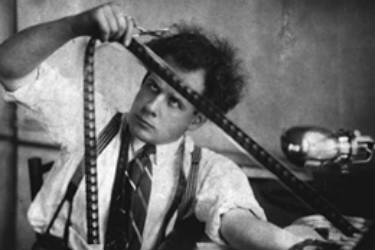Retrospektiva
| whose medieval bobbed hair makes them look startlingly like girls. Ivan has a favourite, a flirtatious, bold-eyed police agent, and many excuses are found for having Ivan put his hands on the handsome young face... There are two open homosexuals in the film, both villains. The minor one is the King of Poland, who is shown in his effete court camping around in a fantastically huge ruff... the major one is the very odd character of Vladimir... It is too much to speculate that Eisenstein identified himself with the homosexual Vladimir, the helpless victim of palace intrigues who just wanted to live in peace (read: to make his films in peace...)"
It is extremely doubtful that Eisenstein, in that he identified with any character in the film, would have chosen the simple-minded, cowardly and effeminate Vladimir. Parker Tyler describes Vladimir as "pretty as a Hollywood starlet... constantly pursing his lips or batting his eyelashes..." Andrew Britton described the scene between the traitor Kurbsky and Sigismond, the King of Poland, as "decadent homosexual flirtation, Kurbsky presenting his sword and Sigismond stroking it languidly with jewelled gloves". Was Eisenstein really planting a clandestine gay time bomb under a perilously homophobic society? Somehow, Eisenstein's "gayness" escaped the censorious eye of Stalin, nor did he ever become a victim of the overt anti-Semitism in the Soviet Union, although he considered himself to have only an eighth of Jewish blood. Suspect comrades were often referred to pejoratively as "cosmopolitans". Riga, the city where he was born, had a fairly large Jewish community. Both in Latvia and Lithuania, the Jews were treated as equals under the law. In Odessa, however, whose population was 30 per cent Jewish, countless Jews were slaughtered in the streets in 1905 in one of the most terrible pogroms in Russian history, the sort of pogrom that must have driven Eisenstein's paternal grandparents to give up their Jewish heritage. But in The Battleship Potemkin, when the sneering bourgeois says, "Down with the Jews", the proletarian population react violently to this remark and attack the man. This sequence was obviously influenced by Eisenstein's friend, the Jewish writer Isaac Babel. While Eisenstein was writing the script of Potemkin, he was simultaneously working with Babel on a script of The Career of Benja Krik, based on the latter's story in Tales of Odessa. There is a further link with Babel, who wrote the inter-titles for a Yiddish film called Jewish Luck, made the year before Potemkin, which has a dream sequence shot on the Odessa steps! The whole of cinema can be defined before and since the "Odessa Steps Sequence" Eisenstein's sublimated homosexuality and Jewishness, which partly explains his "cosmopolitanism", in the objective sense, and his detachment from the mainstream of Soviet artists, only adds another layer to the continuing fascination of his oeuvre and particularly The Battleship Potemkin. In the latter, Eisenstein's method is one of collision, conflict and contrast, with the emphasis on a dynamic juxtaposition of individual shots that forces the audience consciously to come to conclusions about the interplay of images while they are also emotionally and psychologically affected. The 80-minute Battleship Potemkin contains 1,346 shots, whereas the average film around 1926 ran 90 minutes and had around 600 shots. |
But these dry statistics fail to convey the impact of the shots and what they contain. It is well to be reminded that Potemkin presents flesh-and-blood characters and also tells an exciting story (the real Battleship Potemkin pictured below, its Tsarist crest on the prow).
The film starts below deck in the humid sleeping quarters, with its labyrinth of hammocks, heavy with bodies gently swinging. The oscillating motion is later repeated by the pendulous metal tables laden with uneaten bowls of soup. The scene transmits a faint but unmistakable echo of Charlie Chaplin struggling to eat on a similar table in The Immigrant, the kind of analogy to which Eisenstein was never averse. "In the encounter with the squadron, the machines were almost like the heart of Harold Lloyd, jumping out of his waistcoat because it was so agitated," he wrote of the film's final sequence. Nevertheless, everything seems to swirl around the central maelstrom that is universally known as the "Odessa Steps sequence", against which the whole of cinema can be defined before and since. It is surprising that the sequence, having probably been anatomised more than any other, is still as robust as ever. The sequence works on many levels, the formalistic, linked to Marxist dialectics, force (thesis) colliding with counter-force (antithesis) to produce unity (synthesis).
Here are human beings – a legless man rushing to escape, an elderly woman teacher shot in the face, a nursemaid shot in the stomach, leaving her charge in the pram unattended (the suspense of this moment, the pram poised to topple, is positively Hitchcockian), a doctor administering to the wounded, a bespectacled student helplessly regarding the scene in horror, civilians cowering in terror beneath the steps and a mother carrying her dead child towards the advancing soldiers in a plea for mercy in a sudden poignant counterpoint to the main flow of the crowd. It has even more impact because we have already seen these people in a euphoric state before the massacre. As a graphic illustration of state brutality "The Odessa Steps Sequence" is worthy of comparison with Desastros de la Guerra by Goya, one of Eisenstein's favourite artists, and Picasso's Guernica. *The title of the film has tended to a literal translation since the Russian language takes no article – neither definite or indefinite. However, languages which do take articles, such as French, have rendered titles correctly for their own languages eg La Cuirassé Potemkin. The Battleship Potemkin is the correct English translation as we would say The Queen Elizabeth for the ship, and Queen Elizabeth for the person. Ronald Bergan |


